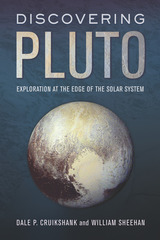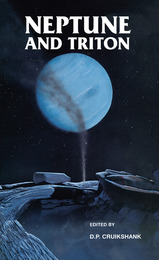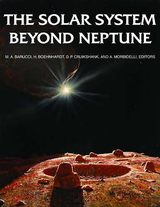3 books about Cruikshank, Dale P.

Discovering Pluto
Exploration at the Edge of the Solar System
Dale P. Cruikshank and William Sheehan
University of Arizona Press, 2018
Discovering Pluto is an authoritative account of the exploration of Pluto and its moons, from the first inklings of tentative knowledge through the exciting discoveries made during the flyby of the NASA New Horizons research spacecraft in July 2015. Co-author Dale P. Cruikshank was a co-investigator on the New Horizons mission, while co-author William Sheehan is a noted historian of the Solar System.
Telling the tale of Pluto’s discovery, the authors recount the grand story of our unfolding knowledge of the outer Solar System, from William Herschel’s serendipitous discovery of Uranus in 1781, to the mathematical prediction of Neptune’s existence, to Percival Lowell’s studies of the wayward motions of those giant planets leading to his prediction of another world farther out. Lowell’s efforts led to Clyde Tombaugh’s heroic search and discovery of Pluto—then a mere speck in the telescope—at Lowell Observatory in 1930.
Pluto was finally recognized as the premier body in the Kuiper Belt, the so-called third zone of our Solar System. The first zone contains the terrestrial planets (Mercury through Mars) and the asteroid belt; the second, the gas-giant planets Jupiter through Neptune. The third zone, holding Pluto and the rest of the Kuiper Belt, is the largest and most populous region of the solar system.
Now well beyond Pluto, New Horizons will continue to wend its lonely way through the galaxy, but it is still transmitting data, even today. Its ultimate legacy may be to inspire future generations to uncover more secrets of Pluto, the Solar System, and the Universe.
Telling the tale of Pluto’s discovery, the authors recount the grand story of our unfolding knowledge of the outer Solar System, from William Herschel’s serendipitous discovery of Uranus in 1781, to the mathematical prediction of Neptune’s existence, to Percival Lowell’s studies of the wayward motions of those giant planets leading to his prediction of another world farther out. Lowell’s efforts led to Clyde Tombaugh’s heroic search and discovery of Pluto—then a mere speck in the telescope—at Lowell Observatory in 1930.
Pluto was finally recognized as the premier body in the Kuiper Belt, the so-called third zone of our Solar System. The first zone contains the terrestrial planets (Mercury through Mars) and the asteroid belt; the second, the gas-giant planets Jupiter through Neptune. The third zone, holding Pluto and the rest of the Kuiper Belt, is the largest and most populous region of the solar system.
Now well beyond Pluto, New Horizons will continue to wend its lonely way through the galaxy, but it is still transmitting data, even today. Its ultimate legacy may be to inspire future generations to uncover more secrets of Pluto, the Solar System, and the Universe.
[more]

Neptune and Triton
Edited by D. P. Cruikshank
University of Arizona Press, 1995
The first reconnaissance of all the major planets of the Solar System culminated in the Voyager 2 encounter with Neptune in August 1989. Neptune itself was revealed as a planet with gigantic active storms in its atmosphere, and off-center magnetic field, and a system of tenuous, lumpy rings. Whereas only two satellites were known prior to the encounter, Voyager discovered six more. Triton, the largest satellite, was revealed as a frozen, icy world with clouds and layers of haze, and with vertical plumes of particles reaching five miles into the thin atmosphere.
This latest Space Science Series volume presents the current level of understanding of Neptune, its rings, and its satellites, derived from the data received from the Voyager. The book's chapters are written by the world's leading authorities on various aspects of the Neptune system and are based on papers presented at an international conference held in January 1992. Covering details of Neptune's interior, atmosphere, rings, magnetic fields, and near-space environment—as well as the small satellites and the remarkable moon Triton—this volume is a unique resource for planetary scientists and astronomers requiring a comprehensive analysis of Neptune viewed in the context of our knowledge of the other giant planets. Until another spacecraft is sent to Neptune, Neptune and Triton will stand as the basic reference on the planet.
This latest Space Science Series volume presents the current level of understanding of Neptune, its rings, and its satellites, derived from the data received from the Voyager. The book's chapters are written by the world's leading authorities on various aspects of the Neptune system and are based on papers presented at an international conference held in January 1992. Covering details of Neptune's interior, atmosphere, rings, magnetic fields, and near-space environment—as well as the small satellites and the remarkable moon Triton—this volume is a unique resource for planetary scientists and astronomers requiring a comprehensive analysis of Neptune viewed in the context of our knowledge of the other giant planets. Until another spacecraft is sent to Neptune, Neptune and Triton will stand as the basic reference on the planet.
[more]

The Solar System Beyond Neptune
Edited by M. A. Barucci, H. Boehnhardt, D. P. Cruikshank, and A. Morbidelli
University of Arizona Press, 2008
A new frontier in our solar system opened with the discovery of the Kuiper Belt and the extensive population of icy bodies orbiting beyond Neptune. Today the study of all of these bodies, collectively referred to as trans-Neptunian objects, reveals them to be frozen time capsules from the earliest epochs of solar system formation. This new volume in the Space Science Series, with one hundred contributing authors, offers the most detailed and up-to-date picture of our solar system’s farthest frontier. Our understanding of trans-Neptunian objects is rapidly evolving and currently constitutes one of the most active research fields in planetary sciences. The Solar System Beyond Neptune brings the reader to the forefront of our current understanding and points the way to further advancement in the field, making it an indispensable resource for researchers and students in planetary science.
[more]
READERS
Browse our collection.
PUBLISHERS
See BiblioVault's publisher services.
STUDENT SERVICES
Files for college accessibility offices.
UChicago Accessibility Resources
home | accessibility | search | about | contact us
BiblioVault ® 2001 - 2024
The University of Chicago Press









